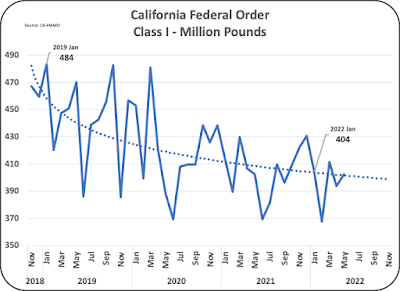California became a Federal Milk Marketing Order in November 2018. California is the largest dairy state, but it is also very different from other U.S. locations. Under the California milk payment system used prior to November 2018, no milk could be de-pooled. With the Federal Order, all but Class I milk for drinking can be de-pooled. Under the California system, milk protein was not paid for specifically, but under the Federal Order system, milk protein is paid for specifically, which should financially stimulate efforts to increase milk protein. ALL the milk processed by the California Federal Order is paid for butterfat, milk protein, and other solids at the Federal Order rates.
California's agricultural system makes certain feed items available and plentiful, but that also makes dairy diets very different from the diets used in most of the U.S.
The mix of milk uses is also very different as California is the largest butter producing state, supplying about one third of the U.S. butter. That makes the California Class IV milk a much larger piece of the milk market than other parts of the U.S. Traditionally Class IV milk is the lowest priced of the four milk Classes.
The four Federal Orders in the middle of the U.S. pay a premium for low somatic cell accounts. When California asked to become a Federal Order, they did not request this provision. While the value added for low somatic cell counts is relatively small, it is still producer revenue paid elsewhere but not paid in California.
To top the list of "different" things in California, there is the adjustment for owning or not owning "Quota." Quota was developed a long time ago to reward those producers that produced just enough milk to meet the demand. If they produced more than what was needed, they were paid less. Over time buying the limited amount of "quota" created value for the quota owners. The USDA did not want to take responsibility for this when California became a Federal Order, so the state of California manages this. Those without Quota must pay into the pool so those that own Quota can receive a payment. There have been many efforts to phase out Quota, but it still exists. Nothing like this exists in any other Federal Order, and as a result California producers who do not own Quota have lower revenue than other Federal Orders.
Class I milk is decreasing very fast in California. During the three years that California has been a part of the FMMO system, Class I milk for drinking decreased by 17 percent (Chart I). The rate of decrease is slowing down, but the volume lost does impact producer milk prices. Class I milk is intended to be the highest paid Class of milk. Because all producers in a Federal Order are paid based on the averages of the four milk classes, when the highest paid milk shrinks in volume, the average price drops.
 |
| Chart I - Class I Milk Paid Through the FMMO |
Class II milk for products like ice cream and yogurt is designed to be the second most valuable Class of milk. The volume of Class II milk is small compared to the other Classes. Unfortunately, the volume of Class II milk (Chart II) in the California Federal Order is also falling.
 |
| Chart II - Class II Milk Paid through the FMMO |
 |
| Chart III - Classes III and IV Milk Paid through the FMMO |
 |
| Chart IV - California cheese Production Since Becoming a Federal Order |
 |
| Chart V |


No comments:
Post a Comment